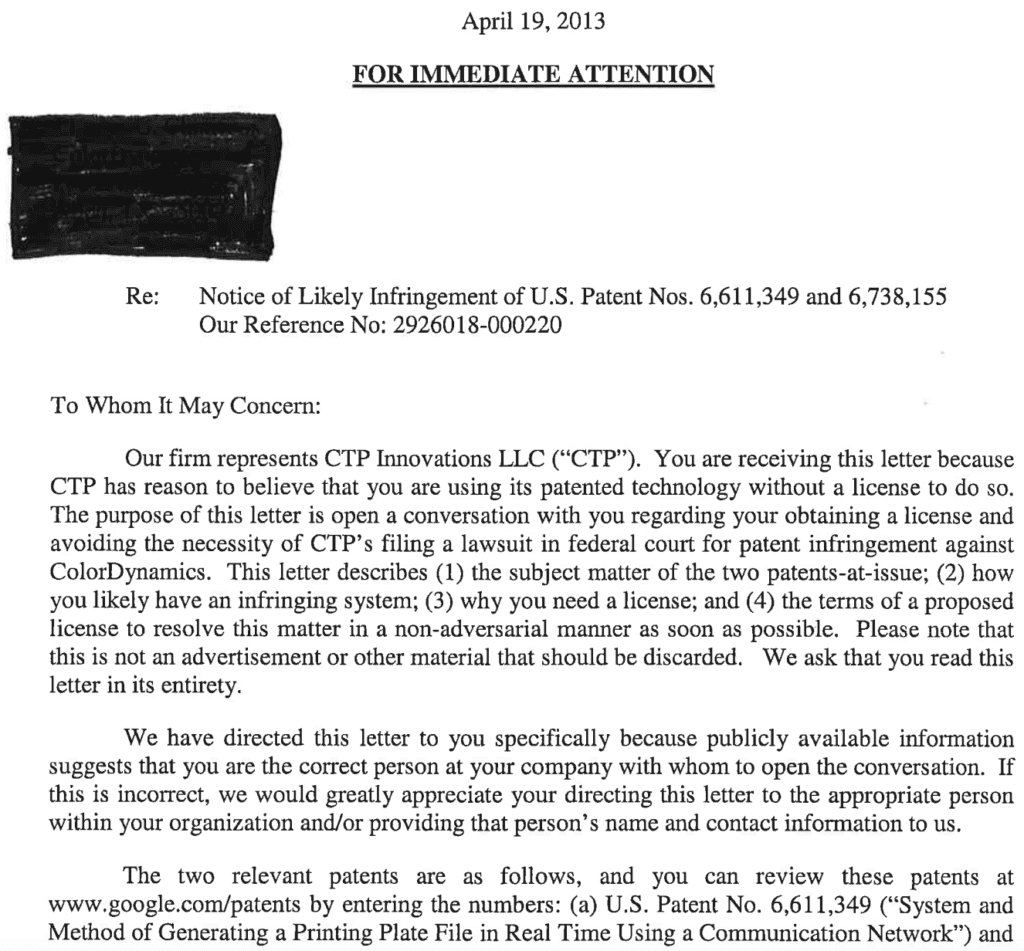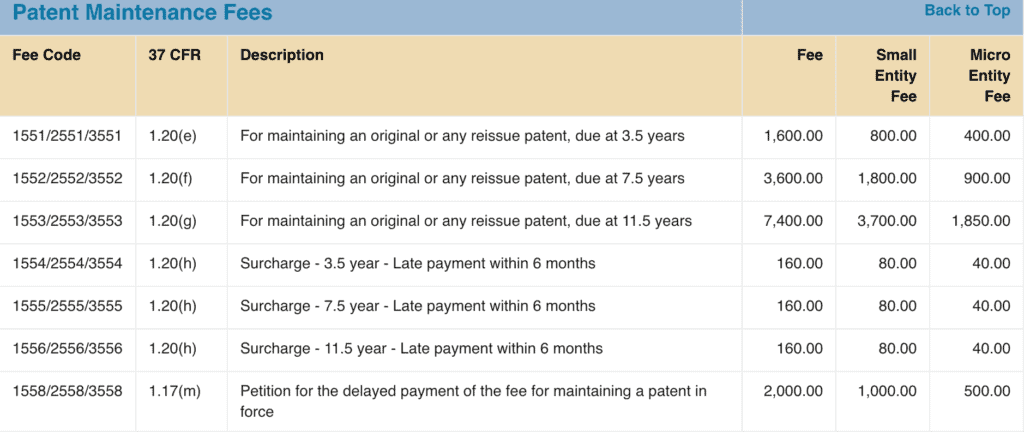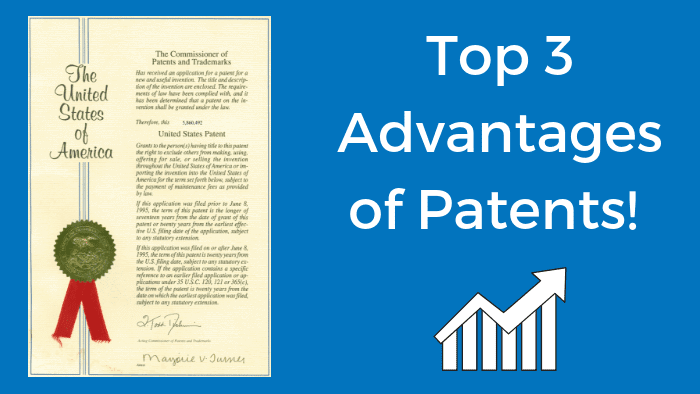We hear it pretty often whether it’s from start-up companies, in the academic setting, from real investors, pitch-competitions, entrepreneurs, and even TV shows like Shark Tank™:
“Great product, but do you have a patent on it?”
There is an amazing amount of interest to “get a patent” on an invention, but aside from the strong belief that the inventor “needs one” – the inventor usually doesn’t really know what it means, let alone what the advantages of a patent really are.
Besides the definition, I feel it’s important to lay out the top 3 advantages of patents for you.
I spend a lot of time talking about the details of the patent process…but it’s equally important to tell you about why patents are a good thing, to begin with!
Patents are a very good thing…but how good?
Definition of Patent:
A patent gives you the right to stop others from copying, manufacturing, selling or importing your invention without your permission. See protecting intellectual property. You get protection for a pre-determined period, allowing you to keep competitors at bay.
Before we get started… here is a video that explains both the advantages and disadvantages of patents. Enjoy!
#1 Advantage of Patents: 20 Years of Exclusivity
For utility patents (if you want to see more about patent types check out our other blog article What is a Patent? to get the full scoop) a patent owner gets 20 years of protection from the filing date.
Design Patents give you 15 years after issuance.
In general terms, a “utility patent” protects the way an article is used and works (35 U.S.C. 101), while a “design patent” protects the way an article looks (35 U.S.C. 171). – Blog Article: Utility Patent vs. Design Patent (everything you need to know…)
The “filing date” means the date of priority for the nonprovisional filing (for a great breakdown between provisional and nonprovisional – check out Step 8 in our blog article How to Patent an Idea).
Even if you file a provisional before a nonprovisional, that earlier filing date, while it will help to have an earlier date to make a claim to, the 20 years is not from the provisional date, it’s from the nonprovisional filing date.
This is a phenomenal right and privilege. It will allow you and your company to price your product/service with plenty of margin for profit, as there will literally be no competition. There will still be market forces, and customers may be finding they are served by a non-infringing alternative.
But, in general, there is plenty of money to be made here!
So, this 20 years of “exclusivity” or “protection”…what does that mean?
It means that no one else in the US can make, use, sell, or import without permission from the patent owner.
This means you get to just relax, and the patent office will keep all the infringers from selling their products, right?
Wrong.
The USPTO does not act as police and they do not enforce your patent rights for you. That’s up to you to do. So, really – 20 years of exclusivity means 20 years of hard work.
A truly valuable invention is one in which there is market demand for it. Without fail, market demand usually means there will be infringers that try to make a quick buck on the consumer demand and ability to capture big margins because of its inherent novelty.
Therefore, a patent owner that is seeking to capitalize on their patent to the greatest extent has to constantly be monitoring the market for which they have patent rights in to see if any potential infringers are out there.
While patent owners could do this monitoring on their own, it’s worthwhile to outsource this work, and then once a suspected infringer has been identified, to get with a Patent Attorney to make a determination on infringement.
From there, a demand letter (also called cease and desist letter) can be sent if there is activity suspected that infringes the rights of the patent holder. Note, there are all types of infringers out there: direct, contributory, and induced.
Demand letters usually point out the specific claims of the underlying patent and how the product infringes each element of one or more claims. Here’s an example:

The letters then go on to describe the infringement in some more detail and then provide some not-so-nice choices for the alleged infringer.
Lastly, in order to enjoy a full 20 years of protection, maintenance fees are due at 3.5, 7.5 and 11.5 years in order to keep the patent enforceable.
These fees are paid not to the Attorneys, but to the USPTO to offset some of their costs.
Depending on the size of the applicant, fees (as of the writing of this article) are shown below:

#2 Advantage of Patents: Transfer, License, or Sell Your Patent
Many inventors and patent owners enjoy a HUGE advantage of being able to transact with their technology by transferring, licensing or selling their patent rights to companies and individuals with the means and desire to bring about action in the market.
This licensing/selling option is a great boon for those inventors who just don’t want to stand guard and monitor the market for 20 years and allows them to do what they do best… invent the next new technology.
Here is a video with more details about patent licensing.
Much like any other piece of real property, there is what’s called a bundle of rights associated with it. Intellectual property, in the form of a patent is no different. Thus, you can gift it to somebody or bequeath the rights as part of your estate by will or living trust after your death.
As the patent owner, you have the right to prevent anyone else from making, using, selling, or importing into the country.
Therefore, you can license out those discrete rights to one or more individuals or companies.
I found an interesting exclusive patent license template that I’ll be using as an example on this section.
When you license a patent grant, the following are the most important aspects to be negotiated:
- Exclusive or Non-Exclusive
- Geographic scope
- Timeframe
- Royalty
Exclusivity: When a patent owner grants exclusive rights to a manufacturer, they are saying that they are the only manufacturing company in the world that is able to make this.
There are special considerations that need to be made, but it puts certain burdens on the licensee to perform, and even to help enforce the patent rights with the patent owner.

Geographic Scope: It’s important to consider that inventions can be protected in multiple countries and therefore multiple markets.
This is a very important part of the negotiated license as far as where the manufacturer (for example) can make the patented products. Below, they left this template completely up for negotiation.

Timeframe: This is critical for licensees and licensors to negotiate on this point – especially if there is only speculation as far as how well the patented item will do in the market.
The licensee may only want to agree to pay a certain royalty for a certain period of time 3-5 years, and then renegotiate.

Royalty: Of course, top of mind for the inventor/patent owner. This is the negotiated amount of money and disbursement frequency that is paid from the licensee to the licensor.
Many different structures exist for this such as per unity royalty, flat-fee, or a combination of those.

Licensing is a big topic that could fill up a major article all on its own, so I’ll save the long-winded explanation for that.
Here is a great video overview:
- Basics
- Monetization
- Upfront payments
- Royalties based on sales
- Enforcing payment terms
- Royalties after patent expiration
- Negotiating royalty rates
Selling a patent can be fairly straightforward, and there is a lot less negotiation involved and less maintaining.
As with a license agreement, both sides will need to monitor to assure there are no breaches.
With a sale, it is usually very clean cut, but comes with some considerations. The high-level consideration is that a patent sale is going to be at a bit of a discount in terms of the overall monetary compensation one might get for a full-term license.
#3 Advantage of Patents: You Don’t Have to Keep it Secret!
Trade secrets are one way to keep valuable information within a company.
There are more risks associated with trade secrets because you have to constantly monitor the employees within your company to make sure information does not leak out. Whereas with patents, once it is filed and issued, it’s public!
Identifying, classifying, and enforcing trade secrets within a company is arduous work. While every state has different employment laws, this is state-specific in terms of the requirements for contracting with employees. The larger the organization, the more difficult it is to keep trade secrets a secret.
Trade secrets have their place though. One should really think twice about seeking patent protection for products that once sold cannot be reverse engineered. I use the classic example of Coca-Cola.
When Coca-Cola was first created, they could have sought a patent on the actual composition of matter or the method for its making, but no one could figure out how they achieved that flavor from the end product alone. Reverse-engineering did no good, and hence is why Coca-Cola STILL has solid protection over their beverage.
For more on trade secrets, check out these videos:
- Why do trade secrets matter?
- Initial Assessment
- Enforcement of Trade Secrets
- Managing Trade Secrets
- Value of Trade Secrets.
When you have a patent, it is part of the public record and it is intended to be shared with everyone in the industry – so purposefully not confidential.
The founding fathers wanted to make sure that before they would grant a 20-year monopoly, that the inventor was going to show everyone how to make and use this new invention.
Other Advantages of Patents…
One of the other major advantages that patents have is that they help promote further discovery in your field and thus increase their value as time elapses.
Say your invention is a groundbreaking discovery that opens up a whole assortment of new inventions; however, each new invention still implements your underlying invention, thus they would still have to have your permission.
And “permission” means a license agreement whereby you as the patent owner get paid for every one of those new innovations that use your technology!
A patent also is a very useful tool when looking for inventors, partners, or clients and the more patents you have the more value and worth your brand and company has when negotiating a merger, public/private offering, or sale.
Another way to realize the benefits/advantages of a patent is to look at the consequences for not pursuing a patent:
- Without patent protection, you will only be able to sell your brand name and good will to third parties and not the actual invention because you do not have exclusive right to it.
- Third parties (often times it’s the well-known companies with deep pockets and large distribution/supply-chains) knowing this will begin to develop their own similar inventions or outright copy your invention, and can usually undercut your pricing.
- In a worst case scenario, you might not only have your invention copied but also might lose rights to your invention all together and become an infringer!
- If you invent a product and another person on the other side of the country comes up with the same invention or something similar after you but files a patent application before you, that person will have superior rights to your invention. This means that this invention would be used against you if you were to go to market with it.
How you decide to use your invention will depend on your own personal situation, but it is well worth pursuing a patent and finding out from a patent attorney or agent what is in your best interest.
In Conclusion
If you’re an inventor you’ve probably heard “Great product, but do you have a patent on it?” many times before, but you may have also wondered WHY patents are a good thing to begin with.
The top three advantages of patents are:
- You get 20 years of exclusivity (protection) for your invention, meaning no one else in the US can make, use, sell, or import your invention without your permission.
- You have the ability to transfer, license, or sell your patent, just like you would a real estate property.
- You don’t have to keep it a secret like you would with a Trade Secret!
What do you think? Do you have a better understanding of why a patent can be used to your advantage?
Please let me know in the comments below!
Are you an investor looking to protect and bring to market your visionary idea?!
Then please grab my free “Inventor’s Guide to Patents Book” when you book your free consultation today!
—
Legal Note: This blog article does not constitute as legal advice. Although the article was written by a licensed USPTO patent attorney there are many factors and complexities that come into patenting an idea. We recommend you consult a lawyer if you want legal advice for your particular situation. No attorney-client or confidential relationship exists by simply reading and applying the steps stated in this blog article.

